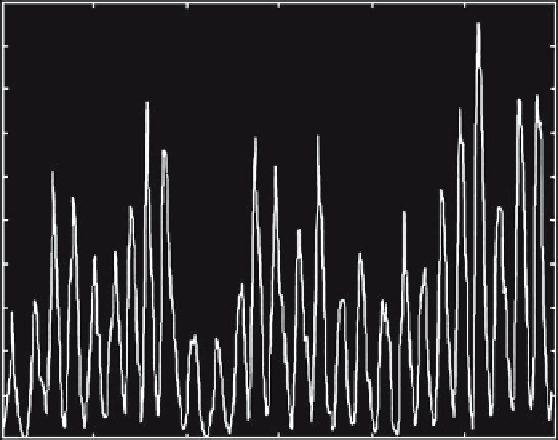Information Technology Reference
In-Depth Information
Sunspot data base
200
180
160
140
120
100
80
60
40
20
0
1700
1750
1800
1850
1900
1950
2000
Fig. 4.5.
Wolf sunspot file from 1700 to 1997
4.1.8 Auto-Regressive Models
The Wolf sunspot file is an example of database that is commonly used as a
benchmark for identification and prediction algorithms. It is maintained since
1700; its variations are shown on Fig. 4.5.
The diagram exhibits some regularity with obvious cycles with approxi-
mate period of 11 years. Therefore, it is natural to look for a law that predicts
the evolution of the phenomenon [Tong 1995]. There is a wealth of papers on
that topic; we consider, for instance, the following model, built up in 1984 by
Subba and Gabr (the original data were first centered):
x
(
k
+1)=1
.
22
x
(
k
)
−
0
.
47
x
(
k
−
1)
−
0
.
14
x
(
k
−
2) + 0
.
17
x
(
k
−
3)
−
0
.
15
x
(
k
−
4) + 0
.
05
x
(
k
−
5)
−
0
.
05
x
(
k
−
6)
...
+0
.
07
x
(
k
−
7) + 0
.
011
x
(
k
−
8) +
v
(
k
+1)
,
where (
v
(
k
)) is a gaussian white noise with variance equal to 199. Such a
model is called an auto-regressive (AR) model.
Thus, an AR(
p
) model is defined by the following regression equation
x
(
k
+1)=
a
1
x
(
k
)+
···
+
a
p
x
(
k
−
p
+1)+
v
(
k
+1)
,
where (
v
(
k
)) is a gaussian white noise. Note that the relevant signal may be
interpreted as the response of a linear filter [infinite impulse response (IIR)]
to white noise [Duvaut 1994].

Search WWH ::

Custom Search